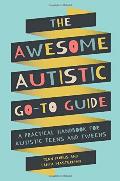What is autism?
Autism is a lifelong developmental disability that affects people in the following areas:
- Communicating and interacting with other people.
- Flexibility in thinking and behaviour.
Autistic people (people who have autism), including children and young people, may also:
- Find it hard to understand how other people think or feel – and people who are not autistic may find it hard to understand how autistic people think or feel.
- Repeatedly do, say or think the same actions or words.
- Find certain sensations, such as loud noises, the feel of particular textures, or bright lights, overwhelming, stressful or uncomfortable.
- Become anxious or upset about unfamiliar situations.
- Take longer to understand information.
Autism is a neurodevelopmental condition – this means it is a difference in the way a person’s brain works and develops.
This is a diagram of the different areas in which autistic children and young people may show differences to children and young people who are not autistic:
Autism is different for everyone
- All autistic children and young people are different.
- Autism is a spectrum condition. This means that different autistic people demonstrate the characteristics of autism in different ways and to different degrees.
Positives of autism
- As well as facing challenges, autistic children and young people demonstrate a number of strengths. For example, autistic people are often able to think about the world in a different way, and some autistic people become experts in subjects or hobbies for which they have a passionate interest.
- Like all children and young people, autistic children and young people will also have their own talents, gifts, passions, people who are important to them, and things in which they find happiness, fulfilment and wellbeing.
Causes of autism
- The cause of autism is not known.
- Autism is not caused by:
- Vaccines, such as the MMR (measles, mumps and rubella) vaccine.
- Parenting.
- Emotional deprivation.
- Diet.
- An infection that can be spread between people.
- Some evidence indicates that autism is caused by a variety of factors that affect the development of the brain, including some genetic factors (genes or combinations of genes that run in families).
Atypical autism
Some autistic traits that can often go unnoticed and not typically associated with the ‘male’ autistic stereotype:
- Females demonstrate a strong ability of ‘masking’, which might appear as laughing along with others even though they didn’t understand the joke or mimicking body language and conversation styles in a bid to fit in.
- Social deficits which are described as ‘shyness’ when the child avoids social interaction and has difficulty understanding the social cues
- Special interests in areas deemed ‘acceptable’, despite being more intensified then their peers, and more likely to go unnoticed.
- Tendency to appear as ‘passive’ and go along with their peers due to difficulties fitting in
- May hold in anxiety through the day that’s released when they get home, often as a ‘meltdown’ or exhaustion
- Difficulty understanding and labelling their emotions
- Aversion and distress at sudden changes in routine
- Avoids larger social gatherings, busy environments or reports feeling unwell when visiting places which are more visually and audibly stimulating.
Did you know?
- One in 100 people is on the autism spectrum.
- There are around 700, 000 autistic people in the UK (ref. National Autistic Society)
- Famous autistic people include climate activist Greta Thunberg, TV presenter Chris Packham and the actors Anthony Hopkins, Dan Ackroyd, Melanie Sykes and Daryl Hannah.
- Sometimes there can be quite a fixed idea of how an autistic person will behave. In reality, autistic people are as diverse as the rest of the population, and you wouldn’t necessarily know from talking to someone that he or she is autistic.
- Various studies suggest that an autism diagnosis is on a scale of 3:1 for males and females, with the outcome being that many autistic features for females are noted instead as ‘anxiety’ due to the strong gender stereotypes.
The page links below are specific pages contained with the Diagnosis Support Pack, which we feel would be of benefit to you.
You can also visit
https://www.autismcentral.org.uk/ for more information and support.
Book Review:
The Awesome Autistic Go-To Guide by Yenn Purkis
This is a guide for young people aged 10-14 on the autism spectrum. It encourages teens and tweens to identify their strengths, suggests how they can develop their identity, and celebrates neurodiversity. It also has tips for managing tricky situations such as anxiety and meltdowns, as well as fun activities and interactive sections.
"I will be reviewing the book The Awesome Autistic Go-To Guide which is by Yenn Purkis and Tanya Masterman. My summary of this book is that it highlights what autism is and that we are all different in our own way. Autism means to me how your outlook is of the world and how you process it. I would definitely recommend the book for ages 13+ due to the content and the easy layout. There is not too much information and it is broken up which I think is important as it helps with not overloading you. I would rate the book five out of five stars as it is definitely a practical handbook, which makes you want to explore autism further and has activities you can complete which are really useful."
by Isma
What do you think of this Neurodiversity Support Pack?- please let us know if there is anything we can improve on or if you have any suggestions for content by clicking on this link
How to use the Neurodiversity Support Pack
All the pages in this pack can be translated into your native language as text or audio via our Recite feature which you will find at the top of each page. The translated page can also be downloaded. More information about using our translation service can be found by
clicking here.